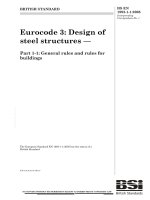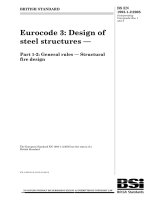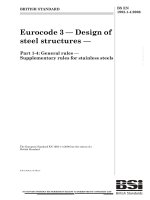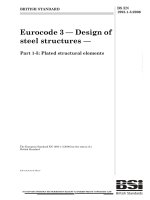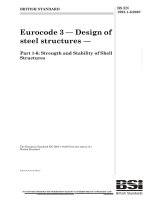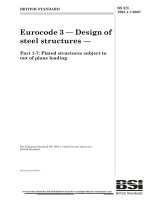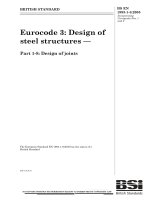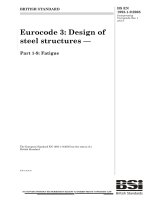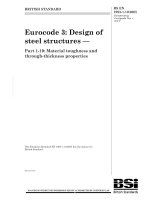Tiêu chuẩn Châu Âu EC3: Kết cấu thép phần 1.5: Cấu kiện tấm (Eurocode3 BS EN1993 1 5 e 2006 Design of steel structures part 1.5: Plated structural elements)
Bạn đang xem bản rút gọn của tài liệu. Xem và tải ngay bản đầy đủ của tài liệu tại đây (667.38 KB, 56 trang )
BRITISH STANDARD
BS EN
1993-1-5:2006
Part 1-5: Plated structural elements
The European Standard EN 1993-1-5:2006 has the status of a
British Standard
ICS 91.010.30; 91.080.10
12 &23<,1* :,7+287 %6, 3(50,66,21 (;&(37 $6 3(50,77(' %< &23<5,*+7 /$:
--```,,`,`````,,`,,``,`,,,,,`,,-`-`,,`,,`,`,,`---
Eurocode 3 — Design of
steel structures —
BS EN 1993-1-5:2006
National foreword
This British Standard was published by BSI. It is the UK implementation of
EN 1993-1-5:2006. It partially supersedes BS 449-2:1969, BS 5400-3:2000 and
BS 5950-1:2000. These standards will be withdrawn by March 2010 at the
latest.
The UK participation in its preparation was entrusted by Technical Committee
B/525, Building and civil engineering structures, to Subcommittee B/525/31,
Structural use of steel.
A list of organizations represented on B/525/31 can be obtained on request to
its secretary.
The structural Eurocodes are divided into packages by grouping Eurocodes for
each of the main materials: concrete, steel, composite concrete and steel,
timber, masonry and aluminium; this is to enable a common date of
withdrawal (DOW) for all the relevant parts that are needed for a particular
design. The conflicting national standards will be withdrawn at the end of the
coexistence period, after all the EN Eurocodes of a package are available.
Following publication of the EN, there is a period allowed for national
calibration during which the National Annex is issued, followed by a
coexistence period of a maximum three years. During the coexistence period
Member States are encouraged to adapt their national provisions. Conflicting
national standards will be withdrawn by March 2010 at the latest. Where a
normative part of this EN allows for a choice to be made at national level, the
range and possible choice will be given in the normative text, and a note will
qualify it as a Nationally Determined Parameter (NDP). NDPs can be a specific
value for a factor, a specific level or class, a particular method or a particular
application rule if several are proposed in the EN. To enable EN 1993-1-5 to be
used in the UK, the NDPs will be published in a National Annex, which will be
made available by BSI in due course after public consultation has taken place.
This publication does not purport to include all the necessary provisions of a
contract. Users are responsible for its correct application.
Compliance with a British Standard cannot confer immunity from
legal obligations.
This British Standard was
published under the authority
of the Standards Policy and
Strategy Committee
on 30 November 2006
Amendments issued since publication
Amd. No.
Date
Comments
© BSI 2006
ISBN 0 580 49667 8
--```,,`,`````,,`,,``,`,,,,,`,,-`-`,,`,,`,`,,`---
EUROPEAN STANDARD
EN 1993-1-5
NORME EUROPÉENNE
EUROPÄISCHE NORM
October 2006
ICS 91.010.30; 91.080.10
Supersedes ENV 1993-1-5:1997
English Version
Eurocode 3 - Design of steel structures - Part 1-5: Plated
structural elements
Eurocode 3 - Calcul des structures en acier - Partie 1-5:
Plaques planes
Eurocode 3 - Bemessung und konstruktion von Stahlbauten
- Teil 1-5: Plattenbeulen
This European Standard was approved by CEN on 13 January 2006.
CEN members are bound to comply with the CEN/CENELEC Internal Regulations which stipulate the conditions for giving this European
Standard the status of a national standard without any alteration. Up-to-date lists and bibliographical references concerning such national
standards may be obtained on application to the Central Secretariat or to any CEN member.
This European Standard exists in three official versions (English, French, German). A version in any other language made by translation
under the responsibility of a CEN member into its own language and notified to the Central Secretariat has the same status as the official
versions.
CEN members are the national standards bodies of Austria, Belgium, Cyprus, Czech Republic, Denmark, Estonia, Finland, France,
Germany, Greece, Hungary, Iceland, Ireland, Italy, Latvia, Lithuania, Luxembourg, Malta, Netherlands, Norway, Poland, Portugal, Romania,
Slovakia, Slovenia, Spain, Sweden, Switzerland and United Kingdom.
EUROPEAN COMMITTEE FOR STANDARDIZATION
COMITÉ EUROPÉEN DE NORMALISATION
EUROPÄISCHES KOMITEE FÜR NORMUNG
Management Centre: rue de Stassart, 36
© 2006 CEN
--```,,`,`````,,`,,``,`,,,,,`,,-`-`,,`,,`,`,,`---
All rights of exploitation in any form and by any means reserved
worldwide for CEN national Members.
B-1050 Brussels
Ref. No. EN 1993-1-5:2006: E
EN 1993-1-5: 2006 (E)
Content
Page
1 Introduction
1.1
1.2
1.3
1.4
5
Scope
Normative references
Terms and definitions
Symbols
5
5
5
6
2 Basis of design and modelling
2.1
2.2
2.3
2.4
2.5
2.6
7
General
Effective width models for global analysis
Plate buckling effects on uniform members
Reduced stress method
Non uniform members
Members with corrugated webs
3 Shear lag in member design
9
3.1 General
3.2 Effectives width for elastic shear lag
3.3 Shear lag at the ultimate limit state
9
9
12
4 Plate buckling effects due to direct stresses at the ultimate limit state
4.1
4.2
4.3
4.4
4.5
4.6
General
Resistance to direct stresses
Effective cross section
Plate elements without longitudinal stiffeners
Stiffened plate elements with longitudinal stiffeners
Verification
5 Resistance to shear
5.1
5.2
5.3
5.4
5.5
13
13
13
13
15
18
21
21
Basis
Design resistance
Contribution from the web
Contribution from flanges
Verification
21
22
22
25
25
6 Resistance to transverse forces
6.1
6.2
6.3
6.4
6.5
6.6
7
7
7
8
8
8
25
Basis
Design resistance
Length of stiff bearing
Reduction factor χF for effective length for resistance
Effective loaded length
Verification
7 Interaction
25
26
26
27
27
28
28
7.1 Interaction between shear force, bending moment and axial force
7.2 Interaction between transverse force, bending moment and axial force
28
29
8 Flange induced buckling
29
9 Stiffeners and detailing
30
9.1
9.2
9.3
9.4
General
Direct stresses
Shear
Transverse loads
30
30
34
35
10 Reduced stress method
36
Annex A (informative) Calculation of critical stresses for stiffened plates
--```,,`,`````,,`,,``,`,,,,,`,,-`-`,,`,,`,`,,`---
2
38
EN 1993-1-5: 2006 (E)
43
Annex C (informative) Finite Element Methods of Analysis (FEM)
45
Annex D (informative) Plate girders with corrugated webs
50
Annex E (normative) Alternative methods for determining effective cross sections
53
--```,,`,`````,,`,,``,`,,,,,`,,-`-`,,`,,`,`,,`---
Annex B (informative) Non uniform members
3
EN 1993-1-5: 2006 (E)
Foreword
This European Standard EN 1993-1-5,, Eurocode 3: Design of steel structures Part 1.5: Plated structural
elements, has been prepared by Technical Committee CEN/TC250 « Structural Eurocodes », the Secretariat
of which is held by BSI. CEN/TC250 is responsible for all Structural Eurocodes.
This European Standard shall be given the status of a National Standard, either by publication of an identical
text or by endorsement, at the latest by April 2007 and conflicting National Standards shall be withdrawn
at latest by March 2010.
This Eurocode supersedes ENV 1993-1-5.
According to the CEN-CENELEC Internal Regulations, the National Standard Organizations of the
following countries are bound to implement this European Standard: Austria, Belgium, Cyprus, Czech
Republic, Denmark, Estonia, Finland, France, Germany, Greece, Hungary, Iceland, Ireland, Italy, Latvia,
Lithuania, Luxembourg, Malta, Netherlands, Norway, Poland, Portugal, Romania, Slovakia, Slovenia, Spain,
Sweden, Switzerland and United Kingdom.
National annex for EN 1993-1-5
This standard gives alternative procedures, values and recommendations with notes indicating where national
choices may have to be made. The National Standard implementing EN 1993-1-5 should have a National
Annex containing all Nationally Determined Parameters to be used for the design of steel structures to be
constructed in the relevant country.
–
2.2(5)
–
3.3(1)
–
4.3(6)
–
5.1(2)
–
6.4(2)
–
8(2)
–
9.1(1)
–
9.2.1(9)
–
10(1)
–
10(5)
–
C.2(1)
–
C.5(2)
–
C.8(1)
–
C.9(3)
–
D.2.2(2)
4
--```,,`,`````,,`,,``,`,,,,,`,,-`-`,,`,,`,`,,`---
National choice is allowed in EN 1993-1-5 through:
EN 1993-1-5: 2006 (E)
1 Introduction
1.1 Scope
(1) EN 1993-1-5 gives design requirements of stiffened and unstiffened plates which are subject to inplane forces.
(2) Effects due to shear lag, in-plane load introduction and plate buckling for I-section girders and box
girders are covered. Also covered are plated structural components subject to in-plane loads as in tanks and
silos. The effects of out-of-plane loading are outside the scope of this document.
NOTE 1: The rules in this part complement the rules for class 1, 2, 3 and 4 sections, see EN 1993-1-1.
NOTE 2: For the design of slender plates which are subject to repeated direct stress and/or shear and also
fatigue due to out-of-plane bending of plate elements (breathing) see EN 1993-2 and EN 1993-6.
NOTE 3: For the effects of out-of-plane loading and for the combination of in-plane effects and out-of-plane
loading effects see EN 1993-2 and EN 1993-1-7.
NOTE 4: Single plate elements may be considered as flat where the curvature radius r satisfies:
r≥
a2
t
where
(1.1)
a is the panel width
t
is the plate thickness
1.2 Normative references
--```,,`,`````,,`,,``,`,,,,,`,,-`-`,,`,,`,`,,`---
(1) This European Standard incorporates, by dated or undated reference, provisions from other
publications. These normative references are cited at the appropriate places in the text and the publications
are listed hereafter. For dated references, subsequent amendments to or revisions of any of these publications
apply to this European Standard only when incorporated in it by amendment or revision. For undated
references the latest edition of the publication referred to applies.
EN 1993-1-1
Eurocode 3 :Design of steel structures: Part 1-1: General rules and rules for buildings
1.3 Terms and definitions
For the purpose of this standard, the following terms and definitions apply:
1.3.1
elastic critical stress
stress in a component at which the component becomes unstable when using small deflection elastic theory
of a perfect structure
1.3.2
membrane stress
stress at mid-plane of the plate
1.3.3
gross cross-section
the total cross-sectional area of a member but excluding discontinuous longitudinal stiffeners
1.3.4
effective cross-section and effective width
the gross cross-section or width reduced for the effects of plate buckling or shear lag or both; to distinguish
between their effects the word “effective” is clarified as follows:
“effectivep“ denotes effects of plate buckling
5
EN 1993-1-5: 2006 (E)
“effectives“ denotes effects of shear lag
“effective“ denotes effects of plate buckling and shear lag
1.3.5
plated structure
a structure built up from nominally flat plates which are connected together; the plates may be stiffened or
unstiffened
1.3.6
stiffener
a plate or section attached to a plate to resist buckling or to strengthen the plate; a stiffener is denoted:
–
longitudinal if its direction is parallel to the member;
–
transverse if its direction is perpendicular to the member.
1.3.7
stiffened plate
plate with transverse or longitudinal stiffeners or both
1.3.8
subpanel
unstiffened plate portion surrounded by flanges and/or stiffeners
1.3.9
hybrid girder
girder with flanges and web made of different steel grades; this standard assumes higher steel grade in
flanges compared to webs
1.3.10
sign convention
unless otherwise stated compression is taken as positive
1.4 Symbols
(1)
In addition to those given in EN 1990 and EN 1993-1-1, the following symbols are used:
Asℓ
total area of all the longitudinal stiffeners of a stiffened plate;
Ast
gross cross sectional area of one transverse stiffener;
Aeff
effective cross sectional area;
Ac,eff
effectivep cross sectional area;
Ac,eff,loc effectivep cross sectional area for local buckling;
a
length of a stiffened or unstiffened plate;
b
width of a stiffened or unstiffened plate;
bw
clear width between welds;
beff
effectives width for elastic shear lag;
FEd
design transverse force;
hw
clear web depth between flanges;
Leff
effective length for resistance to transverse forces, see 6;
Mf.Rd
design plastic moment of resistance of a cross-section consisting of the flanges only;
Mpl.Rd design plastic moment of resistance of the cross-section (irrespective of cross-section class);
MEd
design bending moment;
NEd
design axial force;
t
thickness of the plate;
6
--```,,`,`````,,`,,``,`,,,,,`,,-`-`,,`,,`,`,,`---
EN 1993-1-5: 2006 (E)
VEd
design shear force including shear from torque;
Weff
effective elastic section modulus;
β
effectives width factor for elastic shear lag;
(2)
Additional symbols are defined where they first occur.
2 Basis of design and modelling
2.1 General
(1)P The effects of shear lag and plate buckling shall be taken into account at the ultimate, serviceability or
fatigue limit states.
NOTE: Partial factors γM0 and γM1 used in this part are defined for different applications in the National
Annexes of EN 1993-1 to EN 1993-6.
2.2 Effective width models for global analysis
(1)P The effects of shear lag and of plate buckling on the stiffness of members and joints shall be taken into
account in the global analysis.
(2) The effects of shear lag of flanges in global analysis may be taken into account by the use of an
effectives width. For simplicity this effectives width may be assumed to be uniform over the length of the
span.
(3) For each span of a member the effectives width of flanges should be taken as the lesser of the full
width and L/8 per side of the web, where L is the span or twice the distance from the support to the end of a
cantilever.
(4) The effects of plate buckling in elastic global analysis may be taken into account by effectivep cross
sectional areas of the elements in compression, see 4.3.
(5) For global analysis the effect of plate buckling on the stiffness may be ignored when the effectivep
cross-sectional area of an element in compression is larger than ρlim times the gross cross-sectional area of
the same element.
NOTE 1: The parameter ρlim may be given in the National Annex. The value ρlim = 0,5 is recommended.
NOTE 2: For determining the stiffness when (5) is not fulfilled, see Annex E.
2.3 Plate buckling effects on uniform members
(1) Effectivep width models for direct stresses, resistance models for shear buckling and buckling due to
transverse loads as well as interactions between these models for determining the resistance of uniform
members at the ultimate limit state may be used when the following conditions apply:
–
panels are rectangular and flanges are parallel;
–
the diameter of any unstiffened open hole or cut out does not exceed 0,05b, where b is the width of the
panel.
NOTE: The rules may apply to non rectangular panels provided the angle αlimit (see Figure 2.1) is not greater
than 10 degrees. If αlimit exceeds 10, panels may be assessed assuming it to be a rectangular panel based on the
larger of b1 and b2 of the panel.
--```,,`,`````,,`,,``,`,,,,,`,,-`-`,,`,,`,`,,`---
7
EN 1993-1-5: 2006 (E)
α
b2
--```,,`,`````,,`,,``,`,,,,,`,,-`-`,,`,,`,`,,`---
b1
a
Figure 2.1: Definition of angle α
(2) For the calculation of stresses at the serviceability and fatigue limit state the effectives area may be
used if the condition in 3.1 is fulfilled. For ultimate limit states the effective area according to 3.3 should be
used with β replaced by β ult.
2.4 Reduced stress method
(1) As an alternative to the use of the effectivep width models for direct stresses given in sections 4 to 7,
the cross sections may be assumed to be class 3 sections provided that the stresses in each panel do not
exceed the limits specified in section 10.
NOTE: The reduced stress method is analogous to the effectivep width method (see 2.3) for single plated
elements. However, in verifying the stress limitations no load shedding has been assumed between the plated
elements of the cross section.
2.5 Non uniform members
(1) Non uniform members (e.g. haunched members, non rectangular panels) or members with regular or
irregular large openings may be analysed using Finite Element (FE) methods.
NOTE 1: See Annex B for non uniform members.
NOTE 2: For FE-calculations see Annex C.
2.6 Members with corrugated webs
(1) For members with corrugated webs, the bending stiffness should be based on the flanges only and
webs should be considered to transfer shear and transverse loads.
NOTE: For plate buckling resistance of flanges in compression and the shear resistance of webs see Annex D.
8
EN 1993-1-5: 2006 (E)
3 Shear lag in member design
3.1 General
(1) Shear lag in flanges may be neglected if b0 < Le/50 where b0 is taken as the flange outstand or half the
width of an internal element and Le is the length between points of zero bending moment, see 3.2.1(2).
(2) Where the above limit for b0 is exceeded the effects due to shear lag in flanges should be considered at
serviceability and fatigue limit state verifications by the use of an effectives width according to 3.2.1 and a
stress distribution according to 3.2.2. For the ultimate limit state verification an effective area according to
3.3 may be used.
(3)
Stresses due to patch loading in the web applied at the flange level should be determined from 3.2.3.
3.2 Effectives width for elastic shear lag
3.2.1
(1)
Effective width
The effectives width beff for shear lag under elastic conditions should be determined from:
beff = β b0
(3.1)
where the effectives factor β is given in Table 3.1.
This effective width may be relevant for serviceability and fatigue limit states.
β2: L e = 0,25 (L 1 + L 2)
β1: Le =0,85L 1
β0
β2: L e = 2L 3
β1: Le =0,70L 2
L1
L1 /4
--```,,`,`````,,`,,``,`,,,,,`,,-`-`,,`,,`,`,,`---
(2) Provided adjacent spans do not differ more than 50% and any cantilever span is not larger than half the
adjacent span the effective lengths Le may be determined from Figure 3.1. For all other cases Le should be
taken as the distance between adjacent points of zero bending moment.
L2
L 1 /2
L 1 /4
β1
β2
L2 /4
L3
L 2 /2
L2 /4
β1
β2
β2
Figure 3.1: Effective length Le for continuous beam and distribution of
effectives width
9
EN 1993-1-5: 2006 (E)
b eff
beff
CL
3
b0
b0
for flange outstand
for internal flange
plate thickness t
stiffeners with Asl =
∑A
sli
--```,,`,`````,,`,,``,`,,,,,`,,-`-`,,`,,`,`,,`---
1
2
3
4
4
2
1
Figure 3.2: Notations for shear lag
Table 3.1: Effectives width factor β
κ
κ ≤ 0,02
β – value
β = 1,0
Verification
sagging bending
0,02 < κ ≤ 0,70
hogging bending
sagging bending
> 0,70
hogging bending
all κ
all κ
β = β2 =
1
1 + 6,4 κ 2
1
1
+ 1,6 κ 2
1 + 6,0 κ −
2500
κ
1
β = β1 =
5,9 κ
1
β = β2 =
8,6 κ
β0 = (0,55 + 0,025 / κ) β1, but β0 < β1
β = β2 at support and at the end
end support
Cantilever
κ = α0 b0 / Le with α 0 =
β = β1 =
1+
Asl
b0t
in which Asℓ is the area of all longitudinal stiffeners within the width b0 and other
symbols are as defined in Figure 3.1 and Figure 3.2.
10
EN 1993-1-5: 2006 (E)
3.2.2
Stress distribution due to shear lag
(1) The distribution of longitudinal stresses across the flange plate due to shear lag should be obtained
from Figure 3.3.
σ (y)
σ2
σ (y)
σ1
beff = β b0
σ1
beff =β b0
y
y
b1 = 5β b0
b0
b0
β > 0,20 :
σ 2 = 1,25 (β − 0,20) σ 1
β ≤ 0,20 :
σ2 = 0
σ ( y ) = σ 2 + (σ 1 − σ 2 ) (1 − y / b0 )4
σ ( y ) = σ 1 (1 − y / b1 )4
σ1 is calculated with the effective width of the flange beff
Figure 3.3: Distribution of stresses due to shear lag
3.2.3
In-plane load effects
(1) The elastic stress distribution in a stiffened or unstiffened plate due to the local introduction of inplane forces (patch loads), see Figure 3.4, should be determined from:
σ z ,Ed =
FEd
beff (t w + ast ,l )
with: beff = se
z
1 +
se n
n = 0,636
1+
(3.2)
2
0,878 a st ,1
tw
se = s s + 2 t f
where ast,1
is the gross cross-sectional area of the stiffeners smeared over the length se. This may be taken,
conservatively, as the area of the stiffeners divided by the spacing sst;
tw
is the web thickness;
z
is the distance to flange.
NOTE: The equation (3.2) is valid when sst/se ≤ 0,5; otherwise the contribution of stiffeners should be
neglected.
--```,,`,`````,,`,,``,`,,,,,`,,-`-`,,`,,`,`,,`---
11
EN 1993-1-5: 2006 (E)
se
ss
Fz,Ed
1:1
z
sst
tf
1
tw
σ z,Ed
2
3
beff
1 stiffener
2 simplified stress distribution
3 actual stress distribution
Figure 3.4: In-plane load introduction
--```,,`,`````,,`,,``,`,,,,,`,,-`-`,,`,,`,`,,`---
NOTE: The above stress distribution may also be used for the fatigue verification.
3.3 Shear lag at the ultimate limit state
(1)
At the ultimate limit state shear lag effects may be determined as follows:
a) elastic shear lag effects as determined for serviceability and fatigue limit states,
b) combined effects of shear lag and of plate buckling,
c) elastic-plastic shear lag effects allowing for limited plastic strains.
NOTE 1: The National Annex may choose the method to be applied. Unless specified otherwise in EN 1993-2
to EN 1993-6, the method in NOTE 3 is recommended.
NOTE 2: The combined effects of plate buckling and shear lag may be taken into account by using Aeff as given
by:
Aeff = Ac ,eff β ult
where
Ac,eff
is the effectivep area of the compression flange due to plate buckling (see 4.4 and 4.5);
βult
is the effectives width factor for the effect of shear lag at the ultimate limit state, which may be
taken as β determined from Table 3.1 with α0 replaced by
α 0* =
tf
12
(3.3)
Ac ,eff
b0 t f
is the flange thickness.
(3.4)
EN 1993-1-5: 2006 (E)
NOTE 3: Elastic-plastic shear lag effects allowing for limited plastic strains may be taken into account using
Aeff as follows:
Aeff = Ac ,eff β κ ≥ Ac ,eff β
where
(3.5)
β and κ are taken from Table 3.1.
The expressions in NOTE 2 and NOTE 3 may also be applied for flanges in tension in which case Ac,eff should be
replaced by the gross area of the tension flange.
4 Plate buckling effects due to direct stresses at the ultimate limit state
4.1 General
(1) This section gives rules to account for plate buckling effects from direct stresses at the ultimate limit
state when the following criteria are met:
a) The panels are rectangular and flanges are parallel or nearly parallel (see 2.3);
b) Stiffeners, if any, are provided in the longitudinal or transverse direction or both;
c) Open holes and cut outs are small (see 2.3);
d) Members are of uniform cross section;
e) No flange induced web buckling occurs.
NOTE 1: For compression flange buckling in the plane of the web see section 8.
4.2 Resistance to direct stresses
(1) The resistance of plated members may be determined using the effective areas of plate elements in
compression for class 4 sections using cross sectional data (Aeff, Ieff, Weff) for cross sectional verifications and
member verifications for column buckling and lateral torsional buckling according to EN 1993-1-1.
(2)
Effectivep areas should be determined on the basis of the linear strain distributions with the attainment
of yield strain in the mid plane of the compression plate.
4.3 Effective cross section
(1) In calculating longitudinal stresses, account should be taken of the combined effect of shear lag and
plate buckling using the effective areas given in 3.3.
(2) The effective cross sectional properties of members should be based on the effective areas of the
compression elements and on the effectives area of the tension elements due to shear lag.
(3) The effective area Aeff should be determined assuming that the cross section is subject only to stresses
due to uniform axial compression. For non-symmetrical cross sections the possible shift eN of the centroid of
the effective area Aeff relative to the centre of gravity of the gross cross-section, see Figure 4.1, gives an
additional moment which should be taken into account in the cross section verification using 4.6.
(4) The effective section modulus Weff should be determined assuming the cross section is subject only to
bending stresses, see Figure 4.2. For biaxial bending effective section moduli should be determined about
both main axes.
NOTE: As an alternative to 4.3(3) and (4) a single effective section may be determined from NEd and MEd acting
simultaneously. The effects of eN should be taken into account as in 4.3(3). This requires an iterative procedure.
13
--```,,`,`````,,`,,``,`,,,,,`,,-`-`,,`,,`,`,,`---
NOTE 2: For stiffeners and detailing of plated members subject to plate buckling see section 9.
EN 1993-1-5: 2006 (E)
(5) The stress in a flange should be calculated using the elastic section modulus with reference to the midplane of the flange.
(6)
Hybrid girders may have flange material with yield strength fyf up to φh×fyw provided that:
a) the increase of flange stresses caused by yielding of the web is taken into account by limiting the stresses
in the web to fyw ;
b) fyf (rather than fyw) is used in determining the effective area of the web.
NOTE: The National Annex may specify the value φh. A value of φh = 2,0 is recommended.
(7)
The increase of deformations and of stresses at serviceability and fatigue limit states may be ignored
for hybrid girders complying with 4.3(6) including the NOTE.
(8)
For hybrid girders complying with 4.3(6) the stress range limit in EN 1993-1-9 may be taken as 1,5fyf.
3
2
G´
1
eN
G
G
3
Gross cross section
Effective cross section
G centroid of the gross cross
section
G´ centroid of the effective
cross section
1 centroidal axis of the gross
cross section
2 centroidal axis of the
effective cross section
3 non effective zone
Figure 4.1: Class 4 cross-sections - axial force
3
1
2
G´
3
1
G
Gross cross section
2
G´
Effective cross section
G centroid of the gross cross
section
G´ centroid of the effective
cross section
1 centroidal axis of the gross
cross section
2 centroidal axis of the
effective cross section
3 non effective zone
Figure 4.2: Class 4 cross-sections - bending moment
14
--```,,`,`````,,`,,``,`,,,,,`,,-`-`,,`,,`,`,,`---
G
EN 1993-1-5: 2006 (E)
4.4 Plate elements without longitudinal stiffeners
(1) The effectivep areas of flat compression elements should be obtained using Table 4.1 for internal
elements and Table 4.2 for outstand elements. The effectivep area of the compression zone of a plate with the
gross cross-sectional area Ac should be obtained from:
Ac,eff = ρ Ac
(4.1)
--```,,`,`````,,`,,``,`,,,,,`,,-`-`,,`,,`,`,,`---
where ρ is the reduction factor for plate buckling.
(2)
–
The reduction factor ρ may be taken as follows:
internal compression elements:
ρ = 1,0
ρ=
–
λ p − 0,055 (3 + ψ )
2
λp
≤ 1,0
outstand compression elements:
ρ = 1,0
ρ=
λ p − 0,188
where λ p =
2
λp
fy
σ cr
=
≤ 1,0
for λ p ≤ 0,673
for λ p > 0,673 , where (3 + ψ ) ≥ 0
(4.2)
for λ p ≤ 0,748
for λ p > 0,748
(4.3)
b/t
28,4 ε kσ
ψ
is the stress ratio determined in accordance with 4.4(3) and 4.4(4)
b
is the appropriate width to be taken as follows (for definitions, see Table 5.2 of EN 1993-1-1)
bw
for webs;
b
for internal flange elements (except RHS);
b - 3 t for flanges of RHS;
c
for outstand flanges;
h
for equal-leg angles;
h
for unequal-leg angles;
kσ
is the buckling factor corresponding to the stress ratio ψ and boundary conditions. For long plates kσ is
given in Table 4.1 or Table 4.2 as appropriate;
t
is the thickness;
σcr is the elastic critical plate buckling stress see equation (A.1) in Annex A.1(2) and Table 4.1 and Table
4.2;
ε=
235
f y N / mm 2
[
]
(3) For flange elements of I-sections and box girders the stress ratio ψ used in Table 4.1 and Table 4.2
should be based on the properties of the gross cross-sectional area, due allowance being made for shear lag in
the flanges if relevant. For web elements the stress ratio ψ used in Table 4.1 should be obtained using a stress
distribution based on the effective area of the compression flange and the gross area of the web.
NOTE: If the stress distribution results from different stages of construction (as e.g. in a composite bridge) the
stresses from the various stages may first be calculated with a cross section consisting of effective flanges and
15
EN 1993-1-5: 2006 (E)
gross web and these stresses are added together. This resulting stress distribution determines an effective web
section that can be used for all stages to calculate the final stress distribution for stress analysis.
(4)
Except as given in 4.4(5), the plate slenderness λ p of an element may be replaced by:
λ p ,red = λ p
σ com, Ed
fy /γ M0
(4.4)
where σcom,Ed is the maximum design compressive stress in the element determined using the effectivep
area of the section caused by all simultaneous actions.
NOTE 1: The above procedure is conservative and requires an iterative calculation in which the stress ratio ψ
(see Table 4.1 and Table 4.2) is determined at each step from the stresses calculated on the effectivep crosssection defined at the end of the previous step.
NOTE 2: See also alternative procedure in Annex E.
(5)
For the verification of the design buckling resistance of a class 4 member using 6.3.1, 6.3.2 or 6.3.4 of
EN 1993-1-1, either the plate slenderness λ p or λ p,red with σcom,Ed based on second order analysis with
global imperfections should be used.
(6) For aspect ratios a/b < 1 a column type of buckling may occur and the check should be performed
according to 4.5.4 using the reduction factor ρc.
NOTE: This applies e.g. for flat elements between transverse stiffeners where plate buckling could be columnlike and require a reduction factor ρc close to χc as for column buckling, see Figure 4.3 a) and b). For plates with
longitudinal stiffeners column type buckling may also occur for a/b ≥ 1, see Figure 4.3 c).
a) column-like behaviour
of plates without
longitudinal supports
b) column-like behaviour of an
unstiffened plate with a small
aspect ratio α
c) column-like behaviour of a longitudinally
stiffened plate with a large aspect ratio α
Figure 4.3: Column-like behaviour
--```,,`,`````,,`,,``,`,,,,,`,,-`-`,,`,,`,`,,`---
16
EN 1993-1-5: 2006 (E)
Table 4.1: Internal compression elements
Effectivep width beff
Stress distribution (compression positive)
σ1
ψ = 1:
σ2
be1
beff = ρb
be2
b
be1 = 0,5 beff
1 > ψ ≥ 0:
σ1
σ2
be1
beff = ρb
be2
b
bt
ψ = σ2/σ1
Buckling factor kσ
be1 = 0,4 beff
1>ψ>0
8,2 / (1,05 + ψ)
1
4,0
beff = ρ bc = ρb / (1-ψ)
σ2
be2
b
be2 = beff - be1
ψ < 0:
σ1
be1
2
beff
5 −ψ
be1 =
bc
be2 = 0,5 beff
0
7,81
be2 = 0,6 beff
0 > ψ > -1
7,81 - 6,29ψ + 9,78ψ2
-1
23,9
-1 > ψ > -3
5,98 (1 - ψ)2
Table 4.2: Outstand compression elements
Effectivep width beff
Stress distribution (compression positive)
b eff
1 > ψ ≥ 0:
σ1
σ2
beff = ρ c
c
bt
bc
ψ < 0:
σ1
beff = ρ bc = ρ c / (1-ψ)
σ2
b eff
ψ = σ2/σ1
Buckling factor kσ
1
0,43
0
0,57
b eff
-1
0,85
1 ≥ ψ ≥ -3
0,57 - 0,21ψ + 0,07ψ2
1 > ψ ≥ 0:
σ1
σ2
beff = ρ c
c
b eff
ψ < 0:
σ1
beff = ρ bc = ρ c / (1-ψ)
σ2
bc
ψ = σ2/σ1
Buckling factor kσ
bt
1
0,43
1>ψ>0
0,578 / (ψ + 0,34)
--```,,`,`````,,`,,``,`,,,,,`,,-`-`,,`,,`,`,,`---
0
1,70
0 > ψ > -1
1,7 - 5ψ + 17,1ψ2
-1
23,8
17
EN 1993-1-5: 2006 (E)
4.5 Stiffened plate elements with longitudinal stiffeners
4.5.1
General
(1) For plates with longitudinal stiffeners the effectivep areas from local buckling of the various subpanels
between the stiffeners and the effectivep areas from the global buckling of the stiffened panel should be
accounted for.
--```,,`,`````,,`,,``,`,,,,,`,,-`-`,,`,,`,`,,`---
(2) The effectivep section area of each subpanel should be determined by a reduction factor in accordance
with 4.4 to account for local plate buckling. The stiffened plate with effectivep section areas for the stiffeners
should be checked for global plate buckling (by modelling it as an equivalent orthotropic plate) and a
reduction factor ρ should be determined for overall plate buckling.
(3)
The effectivep area of the compression zone of the stiffened plate should be taken as:
Ac ,eff = ρ c Ac ,eff ,loc + ∑ bedge,eff t
(4.5)
where Ac,eff,loc is the effectivep section areas of all the stiffeners and subpanels that are fully or partially in the
compression zone except the effective parts supported by an adjacent plate element with the width bedge,eff,
see example in Figure 4.4.
(4)
The area Ac,eff,loc should be obtained from:
Ac ,eff ,loc = Asl ,eff + ∑ ρ loc bc ,loc t
(4.6)
c
where
∑
applies to the part of the stiffened panel width that is in compression except the parts bedge,eff,
c
see Figure 4.4;
Asℓ,eff is the sum of the effectivep sections according to 4.4 of all longitudinal stiffeners with gross
area Asℓ located in the compression zone;
bc,loc is the width of the compressed part of each subpanel;
ρloc
is the reduction factor from 4.4(2) for each subpanel.
b1,edge ,eff =
b1 ρ 1
Ac,eff,loc
2
b3,edge,eff
Ac
b1
2
b1
b1ρ1 b2 ρ 2
2
2
b3
2
b2
b3
b1
b2 ρ 2 b3 ρ 3
2
2
b2
Figure 4.4: Stiffened plate under uniform compression
NOTE: For non-uniform compression see Figure A.1.
18
b3
EN 1993-1-5: 2006 (E)
(5) In determining the reduction factor ρc for overall buckling, the reduction factor for column-type
buckling, which is more severe than the reduction factor than for plate buckling, should be considered.
(6) Interpolation should be carried out in accordance with 4.5.4(1) between the reduction factor ρ for plate
buckling and the reduction factor χc for column buckling to determine ρc see 4.5.4.
(7) The reduction of the compressed area Ac,eff,loc through ρc may be taken as a uniform reduction across
the whole cross section.
(8) If shear lag is relevant (see 3.3), the effective cross-sectional area Ac,eff of the compression zone of the
stiffened plate should then be taken as Ac*,eff accounting not only for local plate buckling effects but also for
shear lag effects.
(9) The effective cross-sectional area of the tension zone of the stiffened plate should be taken as the gross
area of the tension zone reduced for shear lag if relevant, see 3.3.
(10) The effective section modulus Weff should be taken as the second moment of area of the effective cross
section divided by the distance from its centroid to the mid depth of the flange plate.
4.5.2
(1)
Plate type behaviour
The relative plate slenderness λ p of the equivalent plate is defined as:
λp =
with
β A ,c f y
σ cr , p
β A,c =
where Ac
(4.7)
Ac ,eff ,loc
Ac
is the gross area of the compression zone of the stiffened plate except the parts of subpanels
supported by an adjacent plate, see Figure 4.4 (to be multiplied by the shear lag factor if
shear lag is relevant, see 3.3);
Ac,eff,loc is the effective area of the same part of the plate (including shear lag effect, if relevant) with
due allowance made for possible plate buckling of subpanels and/or stiffeners.
(2) The reduction factor ρ for the equivalent orthotropic plate is obtained from 4.4(2) provided λ p is
calculated from equation (4.7).
NOTE: For calculation of σcr,p see Annex A.
4.5.3
Column type buckling behaviour
(1) The elastic critical column buckling stress σcr,c of an unstiffened (see 4.4) or stiffened (see 4.5) plate
should be taken as the buckling stress with the supports along the longitudinal edges removed.
For an unstiffened plate the elastic critical column buckling stress σcr,c may be obtained from
σ cr ,c =
π 2 E t2
12 (1 − ν 2 ) a 2
(4.8)
(3) For a stiffened plate σcr,c may be determined from the elastic critical column buckling stress σcr,sl of the
stiffener closest to the panel edge with the highest compressive stress as follows:
σ cr ,sl =
π 2 E I sl ,1
Asl,1 a 2
(4.9)
19
--```,,`,`````,,`,,``,`,,,,,`,,-`-`,,`,,`,`,,`---
(2)
EN 1993-1-5: 2006 (E)
where I sl ,1 is the second moment of area of the gross cross section of the stiffener and the adjacent parts
of the plate, relative to the out-of-plane bending of the plate;
--```,,`,`````,,`,,``,`,,,,,`,,-`-`,,`,,`,`,,`---
(4)
Asl ,1 is the gross cross-sectional area of the stiffener and the adjacent parts of the plate according to
Figure A.1.
NOTE: σcr,c may be obtained from
bc
, where σcr,c is related to the compressed edge of the
bsl ,1
plate, and , bsl1 and bc are geometric values from the stress distribution used for the extrapolation, see Figure
A.1.
The relative column slenderness λ c is defined as follows:
λc =
λc =
with
σ cr ,c = σ cr ,sl
fy
σ cr ,c
β A ,c f y
σ cr ,c
β A ,c =
Asl ,1
Asl ,1,eff
Asl ,1
for unstiffened plates
(4.10)
for stiffened plates
(4.11)
;
is defined in 4.5.3(3);
Asl,1,eff is the effective cross-sectional area of the stiffener and the adjacent parts of the plate with
due allowance for plate buckling, see Figure A.1.
(5) The reduction factor χc should be obtained from 6.3.1.2 of EN 1993-1-1. For unstiffened plates
α = 0,21 corresponding to buckling curve a should be used. For stiffened plates its value should be increased
to:
αe = α +
with i =
0,09
i/e
(4.12)
I sl ,1
Asl,1
e = max (e1, e2) is the largest distance from the respective centroids of the plating and the one-sided
stiffener (or of the centroids of either set of stiffeners when present on both sides) to the neutral
axis of the effective column, see Figure A.1;
α = 0,34 (curve b) for closed section stiffeners;
= 0,49 (curve c) for open section stiffeners.
4.5.4
(1)
Interaction between plate and column buckling
The final reduction factor ρc should be obtained by interpolation between χc and ρ as follows:
ρ c = (ρ − χ c ) ξ (2 − ξ ) + χ c
where ξ =
σ cr , p
− 1 but 0 ≤ ξ ≤ 1
σ cr ,c
σcr,p is the elastic critical plate buckling stress, see Annex A.1(2);
σcr,c is the elastic critical column buckling stress according to 4.5.3(2) and (3), respectively;
20
(4.13)
EN 1993-1-5: 2006 (E)
χc
is the reduction factor due to column buckling.
ρ
is the reduction factor due to plate buckling, see 4.4(1).
4.6 Verification
(1)
Member verification for uniaxial bending should be performed as follows:
η1 =
N Ed
M + N Ed eN
+ Ed
≤ 1,0
f y Aeff
f y Weff
γM0
where Aeff
(4.14)
γM0
is the effective cross-section area in accordance with 4.3(3);
eN
is the shift in the position of neutral axis, see 4.3(3);
MEd
is the design bending moment;
NEd
is the design axial force;
Weff
is the effective elastic section modulus, see 4.3(4);
γM0
is the partial factor, see application parts EN 1993-2 to 6.
η1 =
M y , Ed + N Ed e y , N M z ,Ed + N Ed e z , N
N Ed
+
+
≤ 1,0
f y Aeff
f y W y ,eff
f y Wz ,eff
γ M0
(2)
γM0
(4.15)
γ M0
My,Ed, Mz,Ed
are the design bending moments with respect to y–y and z–z axes respectively;
eyN, ezN
are the eccentricities with respect to the neutral axis.
Action effects MEd and NEd should include global second order effects where relevant.
(3) The plate buckling verification of the panel should be carried out for the stress resultants at a distance
0,4a or 0,5b, whichever is the smallest, from the panel end where the stresses are the greater. In this case the
gross sectional resistance needs to be checked at the end of the panel.
5 Resistance to shear
5.1 Basis
(1) This section gives rules for shear resistance of plates considering shear buckling at the ultimate limit
state where the following criteria are met:
a) the panels are rectangular within the angle limit stated in 2.3;
b) stiffeners, if any, are provided in the longitudinal or transverse direction or both;
c) all holes and cut outs are small (see 2.3);
d) members are of uniform cross section.
(2)
Plates with hw/t greater than
72
η
ε for an unstiffened web, or
31
η
ε kτ for a stiffened web, should be
checked for resistance to shear buckling and should be provided with transverse stiffeners at the supports,
where ε =
235
.
f y N / mm 2
[
]
21
--```,,`,`````,,`,,``,`,,,,,`,,-`-`,,`,,`,`,,`---
NOTE: For members subject to compression and biaxial bending the above equation (4.14) may be modified as
follows:
EN 1993-1-5: 2006 (E)
NOTE 1: hw see Figure 5.1 and for kτ see 5.3(3).
NOTE 2: The National Annex will define η. The value η = 1,20 is recommended for steel grades up to and
including S460. For higher steel grades η = 1,00 is recommended.
5.2 Design resistance
(1)
For unstiffened or stiffened webs the design resistance for shear should be taken as:
--```,,`,`````,,`,,``,`,,,,,`,,-`-`,,`,,`,`,,`---
Vb, Rd = Vbw, Rd + Vbf ,Rd ≤
η f yw hw t
(5.1)
3 γ M1
in which the contribution from the web is given by:
Vbw,Rd =
χ w f yw hw t
(5.2)
3 γ M1
and the contribution from the flanges Vbf,Rd is according to 5.4.
(2) Stiffeners should comply with the requirements in 9.3 and welds should fulfil the requirement given in
9.3.5.
e
bf
tf
Ae
hw
t
a
Cross section notations
a) No end post
b) Rigid end post
c) Non-rigid end post
Figure 5.1: End supports
5.3 Contribution from the web
(1) For webs with transverse stiffeners at supports only and for webs with either intermediate transverse
stiffeners or longitudinal stiffeners or both, the factor χw for the contribution of the web to the shear buckling
resistance should be obtained from Table 5.1 or Figure 5.2.
Table 5.1: Contribution from the web χw to shear buckling resistance
Rigid end post
Non-rigid end post
λ w < 0,83 / η
η
η
0,83 / η ≤ λ w < 1,08
0,83 / λ w
0,83 / λ w
λ w ≥ 1,08
1,37 / 0,7 + λ w
NOTE: See 6.2.6 in EN 1993-1-1.
22
(
)
0,83 / λ w
EN 1993-1-5: 2006 (E)
(2)
Figure 5.1 shows various end supports for girders:
a)
No end post, see 6.1 (2), type c);
b)
Rigid end posts, see 9.3.1; this case is also applicable for panels at an intermediate support of a
continuous girder;
c)
Non rigid end posts see 9.3.2.
(3)
The slenderness parameter λ w in Table 5.1 and Figure 5.2 should be taken as:
λ w = 0,76
f yw
(5.3)
τ cr
where τ cr = kτ σ E
(5.4)
NOTE 1: Values for σE and kτ may be taken from Annex A.
NOTE 2: The slenderness parameter
λw
may be taken as follows:
a) transverse stiffeners at supports only:
λw =
hw
86,4 t ε
(5.5)
b) transverse stiffeners at supports and intermediate transverse or longitudinal stiffeners or both:
λw =
hw
37,4 t ε
kτ
(5.6)
in which kτ is the minimum shear buckling coefficient for the web panel.
NOTE 3: Where non-rigid transverse stiffeners are also used in addition to rigid transverse stiffeners, kτ is taken
as the minimum of the values from the web panels between any two transverse stiffeners (e.g. a2 × hw and a3 ×
hw) and that between two rigid stiffeners containing non-rigid transverse stiffeners (e.g. a4 × hw).
NOTE 4: Rigid boundaries may be assumed for panels bordered by flanges and rigid transverse stiffeners. The
web buckling analysis can then be based on the panels between two adjacent transverse stiffeners (e.g. a1 × hw in
Figure 5.3).
NOTE 5: For non-rigid transverse stiffeners the minimum value kτ may be obtained from the buckling analysis
of the following:
1. a combination of two adjacent web panels with one flexible transverse stiffener
2. a combination of three adjacent web panels with two flexible transverse stiffeners
For procedure to determine kτ see Annex A.3.
(4) The second moment of area of a longitudinal stiffener should be reduced to 1/3 of its actual value
when calculating kτ. Formulae for kτ taking this reduction into account in A.3 may be used.
--```,,`,`````,,`,,``,`,,,,,`,,-`-`,,`,,`,`,,`---
23
